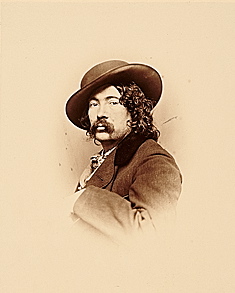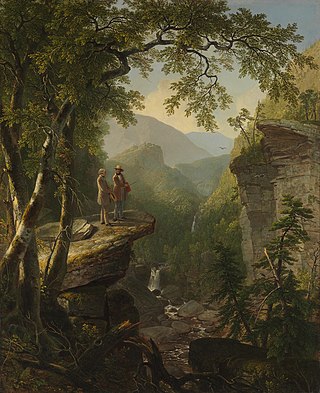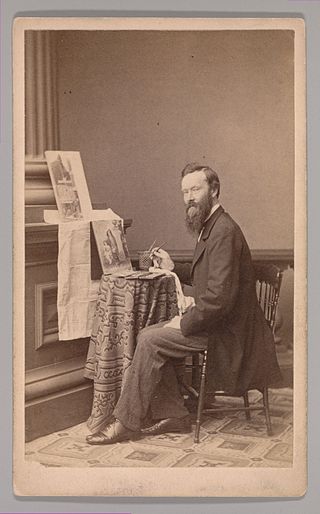
Palenville is a hamlet and census-designated place (CDP) in Greene County, New York, United States. The population was 1,002 at the 2020 census.

George Inness was a prominent American landscape painter.

Frederic Edwin Church was an American landscape painter born in Hartford, Connecticut. He was a central figure in the Hudson River School of American landscape painters, best known for painting large landscapes, often depicting mountains, waterfalls, and sunsets. Church's paintings put an emphasis on realistic detail, dramatic light, and panoramic views. He debuted some of his major works in single-painting exhibitions to a paying and often enthralled audience in New York City. In his prime, he was one of the most famous painters in the United States.

The Hudson River School was a mid-19th century American art movement embodied by a group of landscape painters whose aesthetic vision was influenced by Romanticism. The paintings typically depict the Hudson River Valley and the surrounding area, including the Catskill, Adirondack, and White Mountains.

Thomas Cole was an English-born American artist and the founder of the Hudson River School art movement. Cole is widely regarded as the first significant American landscape painter. He was known for his romantic landscape and history paintings. Influenced by European painters, but with a strong American sensibility, he was prolific throughout his career and worked primarily with oil on canvas. His paintings are typically allegoric and often depict small figures or structures set against moody and evocative natural landscapes. They are usually escapist, framing the New World as a natural eden contrasting with the smog-filled cityscapes of Industrial Revolution-era Britain, in which he grew up. His works, often seen as conservative, criticize the contemporary trends of industrialism, urbanism, and westward expansion.

Asher Brown Durand was an American painter of the Hudson River School.

John Frederick Kensett was an American landscape painter and engraver born in Cheshire, Connecticut. He was a member of the second generation of the Hudson River School of artists. Kensett's signature works are landscape paintings of New England and New York State, whose clear light and serene surfaces celebrate transcendental qualities of nature, and are associated with Luminism. Kensett's early work owed much to the influence of Thomas Cole, but was from the outset distinguished by a preference for cooler colors and an interest in less dramatic topography, favoring restraint in both palette and composition. The work of Kensett's maturity features tranquil scenery depicted with a spare geometry, culminating in series of paintings in which coastal promontories are balanced against glass-smooth water. He was a founder of the Metropolitan Museum of Art.

James McDougal Hart, was a Scottish-born American landscape and cattle painter of the Hudson River School.

Sanford Robinson Gifford was an American landscape painter and a leading member of the second generation of Hudson River School artists. A highly-regarded practitioner of Luminism, his work was noted for its emphasis on light and soft atmospheric effects.

Kindred Spirits (1849) is a painting by Asher Brown Durand, a member of the Hudson River School of painters. It depicts the painter Thomas Cole, who had died in 1848, and his friend, the poet William Cullen Bryant, in the Catskill Mountains. The landscape painting, which combines geographical features in Kaaterskill Clove and a minuscule depiction of Kaaterskill Falls, is not a literal depiction of American geography. Rather, it is an idealized memory of Cole's discovery of the region more than twenty years prior, his friendship with Bryant, and his ideas about American nature.

John William Casilear was an American landscape artist belonging to the Hudson River School.

John Mackie Falconer (1820–1903) was a Scottish-born American etcher, painter, and watercolorist. Born in Edinburgh, he came to the United States in 1836.

Springtime or The Reader is an 1872 painting by the French Impressionist painter Claude Monet. It depicts his first wife, Camille Doncieux, seated reading beneath a canopy of lilacs. The painting is presently held by the Walters Art Museum.

The Café-Concert is an 1879 painting by the French painter Édouard Manet, who often captured café scenes depicting social life at the end of the nineteenth century similar to those depicted in this painting.

The Terrace at Saint-Germain, Spring is a painting by English Impressionist painter Alfred Sisley, completed in 1875. It is in The Walters Art Museum collection.

Sarah Cole (1805–1857) was an American landscape painter and the sister of prominent American landscape painter Thomas Cole. Many of Cole's paintings are similar in subject and visuals to her brother's. Although she was one of the early American female landscape painters, little is known about her life and very few of her paintings have survived or are still in existence.
William Mason Brown (1828–1898) was an American artist.
Mary Josephine Walters (1837–1883), also known as Josephine Walters or M.J. Walters, was part of the 19th century American landscape painting movement known as the Hudson River School. She studied under Asher Durand and specialized in oil and watercolor painting. Though there is not much information about her life, her paintings exhibited much of the immense detail and precision that her mentor’s work did. Much of Walter's painting was done in the Adirondack and Catskill Mountains, though most of her currently known works are of the Hudson River.

Susie M. Barstow was an American painter associated with the Hudson River School who was known for her luminous landscapes.

The Beeches is a mid 19th-century painting by American artist Asher Brown Durand. Done in oil on canvas, the work depicts a forested path in the Northeastern United States. Beeches has been described as one of Durand's earlier works of Naturalist art.


















